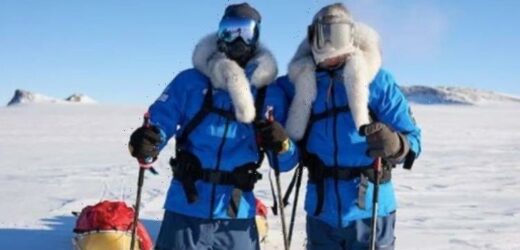Antarctica: Scientists find area where no life exists
We use your sign-up to provide content in ways you’ve consented to and to improve our understanding of you. This may include adverts from us and 3rd parties based on our understanding. You can unsubscribe at any time. More info
The mission, dubbed “Chasing The Light”, is an attempt to cross 2,500 miles of Antarctica in 80 days through what is known as the Pole of Inaccessibility, its most isolated spot. It is being led by former soldier Justin Packshaw, who is accompanied by Jamie Facer Childs, a doctor and former Army medic. The pair have been fighting temperatures of -35C and winds that are over 100mph for the last three weeks, travelling by foot and on skis, pulled by kites and each hauling a 200kg sledge.
They have been working with NASA and Stanford University to collect data on how well humans are able to cope, physically and mentally, when pushed to the limit.
The idea is that the inhospitality and treacherous conditions of Antarctica are not too different from conditions that the next generation of explorers might one day face on the Moon or Mars.
Mr Packshaw told The Times via satellite phone: “It is a proper old-school adventure, long in duration and unsupported.”
Mr Packshaw and Mr Childs are undergoing tests twice a week impact the stress of the adventure has on their cognitive function.
Samples of blood, saliva, urine and faeces are being stored away to keep a check on their immune systems.
And their vital signs, stress levels and sleep are being tracked by smart watches.


NASA are also conducting a study into “psychophysics”, which is the relation between physical stimuli and the sensations and perceptions it produces, and so the explorers are also having their eyesight tested.
According to Dr Katherine Rahill, Senior Scientist at the NASA Human Research Programme, strangely unfamiliar landscapes can catch us off-guard.
She pointed to the example of the Apollo 14 astronauts Alan Shepard and Edgar Mitchell who on their Moon mission back in 1971, initially thought a large crater to be 200-300 yards away from them.
They tried to collect samples from the crater rim but realised it was over a mile away.
They gave up that task and turned back to conserve resources.

But later, they found out they were only 50ft from the crater when they abandoned the mission.
Dr Rahill said: “Shepard and Mitchell were unaware of how close they were to the edge of the crater, and it was likely due to their difficulty in perceiving changes in topographical depth of the lunar surface.”
It is thought the same kind of tricks that were seen on the Moon can be experienced in Antarctica.
DON’T MISS
Dogs should be fed ONCE a day [INSIGHT]
Russia could deliver hammer blow to UK economy [REVEAL]
Brian Cox debunks Big Bang theory: Universe ‘existed before’ [REVEAL]


The polar adventure will also collect data on the polar environment for the European Space Agency (ESA), including wind speed and ultraviolet radiation levels.
Dr Malcolm Davidson, from the ESA, said: “For much of Justin’s journey, measurements such as temperature and surface snow conditions simply do not exist.”
Source: Read Full Article


